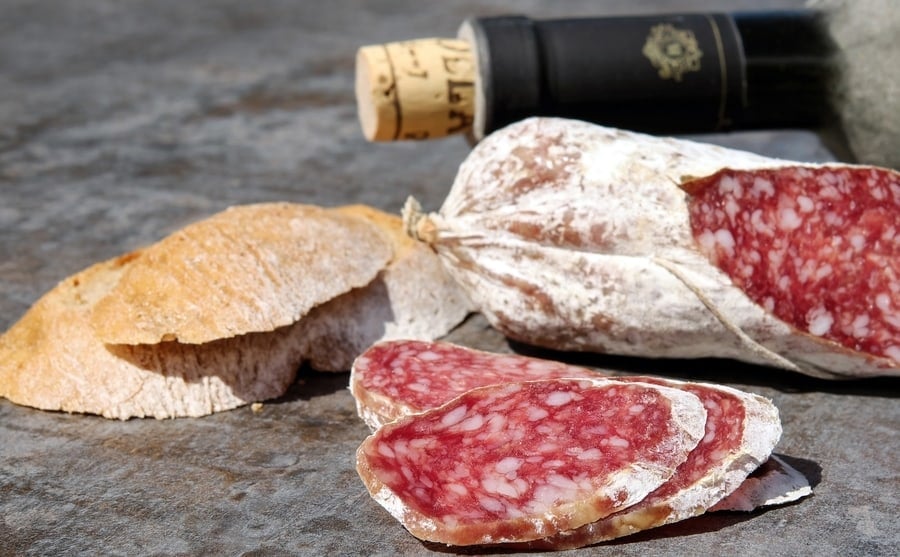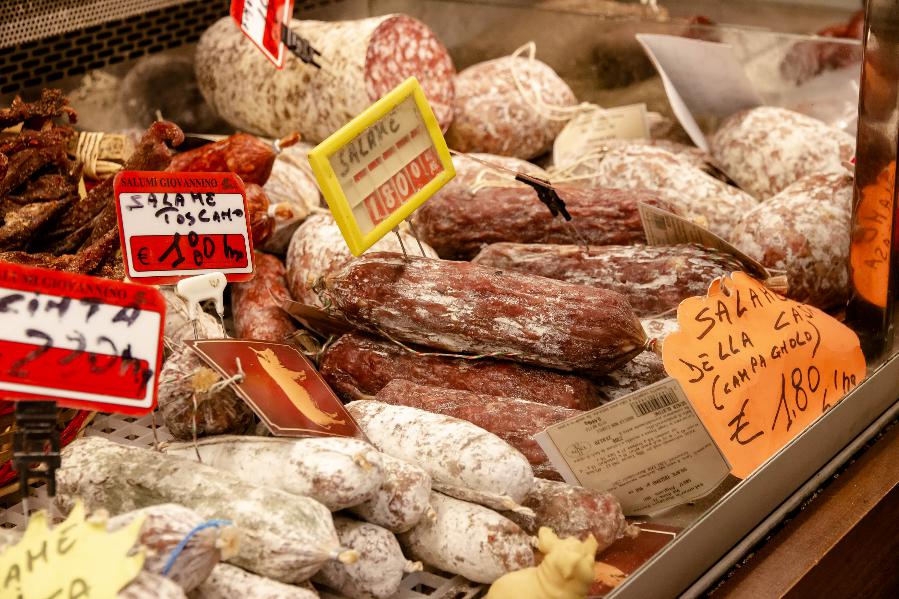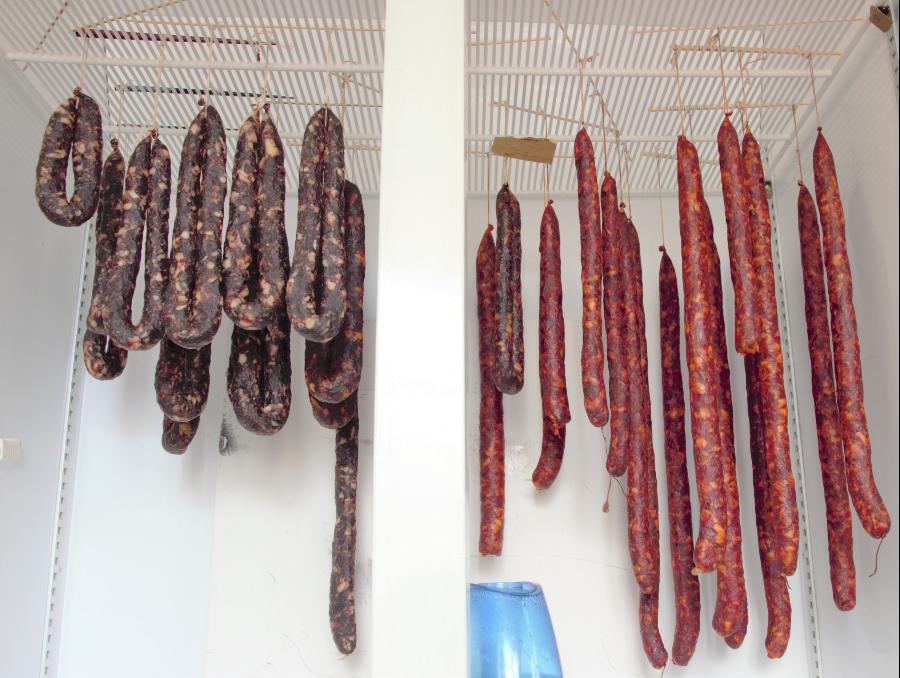Dry-cured salami making is an investment in time and months. Also, I would advise a need for some knowledge on how meat curing works, fermentation/acidic mold cultures, environments for it, and how to dry the cured meat.
have noticed that there are different styles of salami you can make at home, and that can sometimes get confusing.
I’ll also give an overview of different salamis you can make and the process for each style.
Some salamis I make at home take just a day to make, some take a month or much longer. Full traditional large-casing fermented dry-cured salamis could take six months or longer until they are dry enough to be ready for you – it’s all about weight loss for this style.
I have been making salami (here is a link to the category on this site about salami) at home for decades.
At the start of my charcuterie journey, I made cooked all-hot smoked salami (here is how to make salami in a smoker I wrote about), but it wasn’t until I had a fair amount of experience that I started doing dry-cured traditional salami.
Salami, especially dry-cured fermented salami (more on salami fermentation), isn’t just a recipe. Instead, it is a craft that will need your senses and interpretation of changes during the process.
Different Salami You Can Make at Home
Types of Salami You Can Make at Home
- Hot Smoked & Cooked Salami
- Dry Cured Salami
- Cold Smoked / Dry Cured Salami
Hot Smoked and cooked Salami is very similar to making a classic sausage that you would cook.
It would be best to have ground or minced meat; it can vary in the coarseness. As with making sausages, salami needs a certain minimum amount of neutral pork fat so it’s not too dry when consumed. The minimum generally agreed is 20% fat, and meat approximately 80%.
Pork butt or pork shoulder often has around about 20% fat, and you can buy that cut of meat, and you don’t need to source specific pork back fat. You then can cut the shoulder into cubes for mincing/grinding.
I like to grind my fat and meat separately, but it also depends on the meat. Some pork is relatively soft compared to the wild venison I use, which needs to be carefully trimmed of sinew.
The minced meat is mixed with salt and spices. It is then stuffed into a natural or synthetic casing. These can vary from 20 mm in diameter to 150 mm.
Then, for a hot smoked cook, salami is often put in a smoker at a cooking temperature of 200°F or 100°C.
The idea is that it is slightly cooked until a 145°F/65°C internal cooked pork temperature is reached.
The idea is the fat hasn’t rendered down and is still in a solid state to some degree.
Dry-cured salami often has a fermentation stage added, and the salami is not cooked. It uses salt and the higher acidity from the fermentation to protect the meat during the drying phase.
I will elaborate more on this process below, but it’s an involved process as well as a craft. It’s what most would consider the ‘real’ salami.




It’s not the same as baking a cake since you are trying to create an environment inside and outside the salami to reach a level of preservation and an added dimension to the meat flavor! (Although using wild sourdough yeast and high-hydration dough is an art and craft too! My better half is keen on that craft!)
You can make either a hot and cooked salami or dry-cured salami at home. The main tools are a grinding mincing tool for the meat and some stuffing device to put the meat into a casing.
Hopefully, I’ll give you an idea of the environment and equipment needed to demystify the process below.
Fermented dry-cured salami is not something that I would advise people to jump into before having a good understanding of dry-cured meats. I often point people toward my online course first to do at least a few projects where you can see how the process comes together.
With whole muscle dry curing, there is less chance of unwanted bacteria getting into the meat because you have one big chunk of meat.
As soon as you start grinding and mincing meat, you create an opportunity for the unwanted bacteria. This is one of the reasons why starting off with whole muscle is better than making dry-cured salami.
Below are the main aspects of Making Salami at Home:
- Understanding of Curing & Drying Process
- What You Need to Make Salami at Home
- How Do you Dry Salami at Home
- Ingredients in Salami
Dry Cured Salami – Curing & Drying Process
Curing
The curing aspect is mainly the salt that inhabits the meat, and the process of binding to the meat cells and diffusion of the water activity are the critical aspects of the curing process in making salami at home.
With dry-cured salami, you curing and drying the meat simultaneously in some ways. With whole muscle dry-cured meat like pancetta or prosciutto, first, it’s cured, then it’s dried. You remove the salt from the meat after it has ‘inhibited’ it so it doesn’t get too salty.
For long-term storage, like salt pork, the pork was left in the salt for a long time for preservation effects, but then it’s so salty it generally needs to be purged of salt before consumption.
Depending on the dry-cured salami project, short-term or long-term nitrates for nitrites are often added. These perform a role in protecting the meat from botulism.
In the United States it’s commonly called pink curing salt I wrote a post here all about it.
Drying

Often, the fermentation part of the process involves adding a starter mold culture, which acidifies the salami quickly or slowly, depending on the type. Then, the salami is drying, ideally needing around or above 70% humidity up to about 85% humidity and around 60°F/15°C temperature.
This is why I put together a DIY drying chamber at home. I think I have had five over the years. The latest addition is the out-of-the-box SteakAger Pro 40 (review soon).
However, I have previously had secondhand fridges, ideally frost-free, sometimes not. Then, I plugged the fridge into the controller, turning it off to keep the temperature in the desired range.
Then, have another plug-and-play controller for a humidifier and dehumidifier.
It creates a controlled environment for drying salami and whole-muscle pieces of meat.
I have written a post about how I put together DIY curing chambers, you can also get sent a guide with tips and tricks on how to make your own here.
What You Need To Make Salami at Home
Of course, you need the ingredients such as salt, spices, and casings. More on the ingredients below, let’s go over the equipment.
If you’re making the cooked hot-smoked salami, you could potentially buy the minced meat; however, you never know how long it’s been sitting around for, and often, the grind is OK, say 2-3mm, where you may want chunkier meat and fat for a hot-smoked salami.
I always advise that you grind and mince your meat; therefore, you would want a meat grinder or mincer. Then, you get to choose the thickness of the meat and chunkiness.
Here is a write-up I did about grinders for salami and sausages.
You can get attachments for standing mixes to turn them into stuffers for sausages, which generally aren’t very good, and you’re better off getting a sausage stuffer. This is due to heat and speed, two aspects of making salami you are always trying to avoid.
Stuffing can be done in many ways, I wrote about stuffers at the bottom of this page.
How Do You Dry Salami at Home?
As mentioned above, you can use an out-of-the-box solution like SteakAger, put together your DIY drying chamber, or just hang the salami around your house in the basement or seller.
The issue is hanging it in a cellar or basement; unless you’ve tested the environment, you never know what you’re getting yourself into or what invisible mold cultures are around!
Traditionally, in Italy, they often dried the salami in caves (in Umbria, I know this). Once a drying chamber has been established and good bacteria, which is a form of penicillin, grow, they inoculate your whole muscle salami after a few days of being in the vicinity of the good bacteria. The same happened in damp caves!
What are the Ingredients in Salami?
Salt
Sea salt in a fine form is the way to go here; coarse salt can best be put in a mortar and pestle or spice/coffee grinder.
Any additives may lead to unwanted outcomes, so no anti-caking or iodized salt.
Spices / Nuts
Spices: There are so many options for your at-home salami!
Pepper and garlic are used a lot in salami recipes.
Nuts like macadamia and hazelnut can be found in classic dry-cured salami across France and Italy!
Sodium Nitrates / Nitrites
For under 30 days to finish salami or cured meats, pink curing salt no.1 is generally used; for over 30 days, pink curing salt no. 2 is used. I wrote a post on this – Read more on these additives here.
Fermentation Starter Cultures
In some places worldwide, it can be hard to get it since they need to stay in a freezer; if transported or shipped for multiple, it may compromise it.
You can get fast or slow fermenting cultures. You add them to a salami mix after the salt and spices. Then, you hang the salami at a fermenting temperature for the acidification to kick start.
A pH meter can also be used for certainty around this.

Tom Mueller
For decades, immersed in studying, working, learning, and teaching the craft of meat curing, sharing the passion and showcasing the world of charcuterie and smoked meat. Read More

I like to know more about making different dried sausages and salamis . I love to speak and gain some knowledge.
Hey there, I have my course on whole muscle salumi style, and I am working on a bacon course currently, with 5 different ways/styles of making bacon. I am then going to look at a salami course! But salami is a more advanced and complex type of charcuterie/meat curing definitely!
All the best,
Tom
So you wouldn’t recommend just using ground beef from the grocery store to make beef salami?
I definitely wouldn’t, unless i talked to the butcher and found out where it came from, how long since it was killed etc.